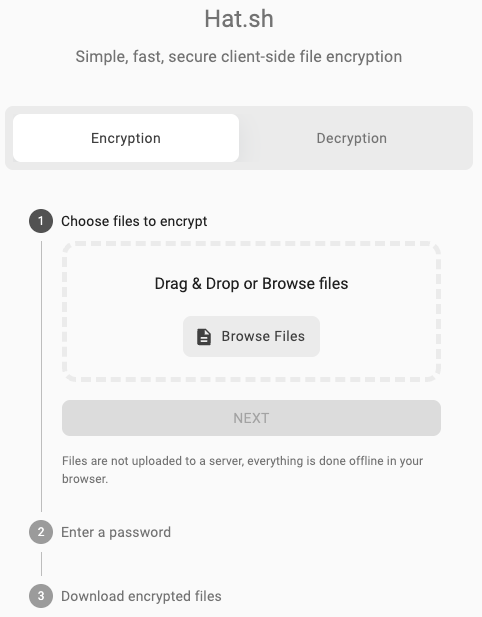Browser File Encryption
As of 2025-08-01, the default browser file encryption software is based on hat.sh.
hat.sh supports BOTH passwords or keys, but the use of password is discouraged.
2.1. Encryption
A file can be encrypted with either Password or Keys.
2.1.1. Encrypt with Shared Password
- Navigate to the Encryption panel.
- Drag & Drop or Select the files that you wish to encrypt.
- Enter a password or generate one.
- Download the encrypted file.
2.1.2. Encrypt with their Public Key and your Private Key
- Navigate to the Encryption panel.
- Drag & Drop or Select the files that you wish to encrypt.
- Choose public key method.
- Enter or load recipient's public key and your private key. if you don't have public and private keys you can generate a key pair.
- Download the encrypted file.
- Share your public key with the recipient so he will be able to decrypt the file.
2.2. Decryption
A file can be decrypted with either Password or Keys.
2.2.1. Decrypt with Shared Password
- Navigate to the Decryption panel.
- Drag & Drop or Select the files that you wish to decrypt.
- Enter the encryption password.
- Download the decrypted file.
2.2.2. Decrypt with their Public and your Private Key
- Navigate to the Decryption panel.
- Drag & Drop or Select the files that you wish to decrypt.
- Enter or load sender's public key and your private key.
- Download the decrypted file.
3. Technical Information
Hat.sh Release History
Hat.sh uses the same NaCl technology as us in Dynamic Alias (they use the libsodium library) so there is a good understanding of the way Hat.sh performs encryption.
- X25519 - for key exchange.
- XChaCha20-Poly1305 - for symmetric encryption.
- Argon2id - for password-based key derivation.
